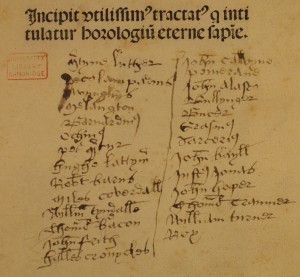The Library’s incunabula exhibition, Private Lives of Print: the use and abuse of books 1450-1550 opened to great acclaim on 23 October 2014. Thanks to a generous donation from the Howard and Abby Milstein Fund we are able to photograph every item in the cases for a virtual exhibition which will remain after the physical display closes. Given the short exhibition changeover period (only eight working days in this instance) the books were photographed in advance, many of them flat or as single pages, rather than in their final cradles.
There has been a great deal of interest from other specialist librarians and exhibition curators in the way we have displayed the books. The process of preparation for this particular exhibition was considerably more intensive than in previous cases; the theme of the exhibition focuses primarily on books as objects, rather than on the texts within, meaning that they need to be displayed in unusual and often unique ways. The Library’s Conservation team leapt at the challenges this created: how to show multiple openings at once; how to hang broadsides as if nailed to the back of the case; how to display a binding and its endpapers simultaneously. Some of the stands took several months to design, and were manufactured by Engineering Design and Plastics, a local firm. Other special features of the display, such as the maniculae pointing at marginal markings in our Gutenberg Bible, were dreamed up only in the last few days of the mounting process and created with a Blue Peter-esque level of ingenuity. The curators and exhibitions officers are immensely grateful to the Conservation team for their patience, imagination and dedication to this exhibition, and a few samples of their work are shown here. Some of the photographs were taken professionally at the exhibition opening, others by a member of staff, so please excuse the variation in quality. Continue reading 'Displaying incunabula: a labour of love'»

Tim Munby (1913-1974)
In June the Special Collections blog advertised an exhibition in the Library to coincide with a conference – held at King’s College – in honour of Tim Munby, Librarian of King’s from 1947 until his early death in 1974, who was born a century ago this year. The exhibition drew extensively on Tim’s own library of sale catalogues and bibliographical works, a large portion of which (1800 volumes) was purchased by the University Library after his death. But with the actual centenary of his birth approaching (he was born on Christmas Day 1913), we thought this a good time to consider the many donations he made to the Library during his lifetime. These include four incunabula (in addition to a further incunable owned by Munby which was bought by the Library), recently catalogued online as part of the Library’s five-year incunabula cataloguing project, and many rare eighteenth- and nineteenth-century books.
Continue reading 'Tim Munby’s donations to Cambridge University Library, a post by Laura Nuvoloni and Liam Sims'»

The sixteenth-century list on the first leaf of Henry Suso’s Horologium aeternae sapientiae
(Alost: Thierry Martens [between 1486 & 1492]), Inc.5.F.1.3[3154], ISTC is00874000
Among the Library’s
recently catalogued incunabula is a copy of Henry Suso’s
Horologium aeternae sapientiae, printed by Thierry Martens between 1486 and 1492 in the town of Alost (present-day Aalst), twenty miles northwest of Brussels. This small volume bears few signs of early use, having been rebound early in the twentieth century, with no contemporary decoration or textual annotation. One of just three copies of this edition in the UK, it has been in the University Library for almost 350 years, having arrived in 1664 with the
bequest of Richard Holdsworth (1590-1649), Master of Emmanuel College and Vice-Chancellor of the University in 1640. Its one interesting (and slightly puzzling) feature is a sixteenth-century list written on the first leaf, which may give us some insight into the religious turmoil of sixteenth-century Cambridge.
Continue reading 'A sixteenth-century Cambridge provenance for a Belgian incunable?'»
Cambridge University Library possesses four copies of the Ninth German Bible, considered to be one of the most beautiful of all German Bibles, printed in Nuremberg by Anton Koberger in 1483. Koberger is most well known as the printer of the Liber Chronicarum (Nuremberg Chronicle) and this Bible is no less splendid a production, and on a similarly grand scale. The Incunabula Short Title Catalogue lists nearly 300 extant copies, in varying degrees of completeness, and estimates of the print run range from 1000 to 1500. The text was taken primarily from the Fourth German Bible printed by Zainer in Augsburg in 1475 while the 109 images were produced using woodcuts by the Master of the Colgone Bible; Koberger purchased these after they were first used by Heinrich Quentell for his Low German Bible (Cologne, 1478). Continue reading 'Bound with leaves from the Bible; identifying “paper wrappers”'»

